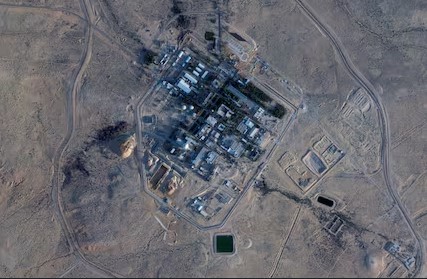New satellite photos have revealed major construction activity at a highly sensitive site in Israel, long linked to the country’s secretive Israel nuclear programme. The site in question is the Shimon Peres Negev Nuclear Research Centre, located near the city of Dimona, about 90 kilometres south of Jerusalem.
Satellite Images Reveal Intensified Construction Linked to Israel Nuclear Programme
The pictures, taken on July 5 by Planet Labs PBC, show intensified work at the site, including large cranes and thick concrete retaining walls. The construction appears to involve multiple underground levels, suggesting a complex structure is being built. Experts who examined the images believe the project is closely tied to the Israel nuclear programme, though its exact purpose remains unclear.
What makes this development significant is the long history of secrecy around Dimona. Israel does not officially confirm or deny possessing nuclear weapons, maintaining a policy known as “nuclear ambiguity.” This means the country refuses to say whether it has atomic bombs, although many experts and international organisations believe it does.
🕊️ North Korea Sides with Iran — Israel & U.S. Are ‘Cancer’ to Peace in Middle East
Expert Analysis of Construction at Dimona and Israel Nuclear Programme
Seven nuclear experts reviewed the satellite photos and all agreed that the work is related to the Israel nuclear programme. However, they were divided on what the new structure could be. Three experts suggested that the scale and design of the site indicate the construction of a new heavy water reactor. Such reactors can produce plutonium, a key ingredient in nuclear weapons.
Israel’s current reactor at Dimona has been operating since the 1960s. This makes it far older than most reactors still in use worldwide. Experts say Israel may need to replace or upgrade this ageing facility. That need could explain the ongoing work tied to the Israel nuclear programme.
The other four experts said the site could be a heavy water reactor. They also suggested it might serve as a facility for assembling nuclear weapons. The experts pointed to the underground construction as evidence. In addition, they highlighted the absence of features that civilian power reactors usually include, such as a containment dome. At this stage, however, they stressed the evidence does not provide a definitive answer.
🛢️ Billion-Dollar Blow! U.S. Cracks Down on Iran’s Covert Oil Empire Fueling Middle East Chaos
Jeffrey Lewis, a nuclear researcher at the James Martin Centre for Nonproliferation Studies, described the construction as “probably a reactor.” He also admitted his judgment was based on circumstantial evidence. Similarly, Edwin Lyman from the Union of Concerned Scientists said the site could hold a reactor without a visible containment dome. But Israel’s lack of transparency forces analysts to keep guessing about the Israel nuclear programme.
The secrecy surrounding Dimona means there is little outside oversight. Israel is not a member of the Nuclear Non-Proliferation Treaty (NPT). This treaty allows the International Atomic Energy Agency (IAEA) to monitor nuclear sites in other countries. Because Israel has not joined, the IAEA has no authority to inspect Dimona. It also cannot demand information from Israel about its nuclear facilities.
A History of Secrecy and Speculation
The Dimona site has been central to debates over the Israel nuclear programme for decades. In the 1980s, a whistle-blower released photographs and documents that suggested Israel had developed dozens of nuclear warheads. More recently, a 1971 declassified U.S. spy satellite photo confirmed the existence of the Dimona facility, reinforcing suspicions about its purpose.
Analysts believe Israel uses heavy water reactors like the one at Dimona to produce plutonium and tritium. Plutonium powers the nuclear chain reaction that makes an atomic bomb explode, while tritium boosts the explosive power of warheads. Tritium, however, decays over time—losing about five percent of its potency each year. This decay could be one reason why Israel is building a new facility to replenish or maintain its existing stockpile as part of the Israel nuclear programme.
The Bulletin of Atomic Scientists estimated in 2022 that Israel possesses around 90 nuclear warheads. Unlike the United States, Russia, or China, Israel has never publicly displayed its weapons or admitted to having them. Yet, experts widely consider Israel the only nuclear-armed nation in the Middle East.
🌍🔥 Axis of Aggression: Russia Helping Iran Revive Nuclear Programme, Warns Zelenskyy
The secrecy is deliberate. Since its founding in 1948, Israel has faced multiple wars with its neighbours. Experts believe the policy of nuclear ambiguity has acted as a deterrent against threats, allowing Israel to signal its strength without openly declaring its arsenal.
The construction at Dimona has already attracted international attention, particularly because of recent events. In June, Israel and the United States conducted strikes against nuclear sites in Iran, including the heavy water reactor at Arak, citing concerns about Iran’s nuclear ambitions. The timing of Israel’s own construction work raises fresh questions and could invite criticism from the international community.
For now, what is clear is that significant changes are taking place at one of the world’s most secretive nuclear facilities. The exact nature of the construction remains uncertain, but its location and history strongly tie it to the Israel nuclear programme.

